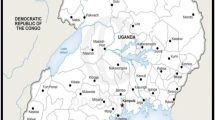Abstract
In an effort to advance fuel security in this era of increasing fuel demand and climate change, crop residue can play an important role by serving as an alternative source of biofuel feedstock. Crop grain yield and residue production are tied to the changing climate over regional and global scale. Precipitation and temperature are among the prime climate variables that drive agricultural production across the globe. This study was carried out to understand the effect of temperature and precipitation on spatial distribution of crop residue yield potential at regional scale. Spatial autoregressive models were fitted for county level crop residue yield potential (as a major potential biomass feedstock) in the north central region of the United States using daily mean temperature and total precipitation during the crop growing season. The results of this observational study found the linear increasing trend in crop residue yield potential in most of the states across north central region of USA. Crop residue potential was also identified to have significant spatial variability. The influences of temperature and precipitation on crop residue yield potential exhibited significant interactions. Positive interaction effects were observed in states including Iowa, North Dakota, and Wisconsin. Negative interaction effects of daily mean temperature and total precipitation were observed in states including Illinois and Indiana. These results emphasize that the availability of crop residues for biofuels feedstocks will be sensitive to climatic variability and that these sensitivities will vary geographically.
Similar content being viewed by others
References
Bakker MM, Grovers G, Ewert F, Rounsevell M, Jones R (2005) Variability in regional wheat yields as a function of climate, soil and economic variables: assessing the risk of confounding. Agric Ecosyst Environ 110:195–209
Challinor AJ, Slingo JM, Wheeler TR, Craufurd PQ, Grimes DIF (2003) Toward a combined seasonal weather and crop productivity forecasting system: determination of the working spatial scale. J Appl Meteorol 42:175–192
Chintala R, Wimberly MC, Djira GD, Tulbure MG (2013) Interannual variability of crop residue potential in the north central region of the United States. Biomass Bioenergy 49:231–238
Cressie NAC (1993) Statistics for spatial data. Wiley, New York
Haining R (1990) Spatial data analysis in the social and environmental sciences. Cambridge University Press, Cambridge
Kendall MG, Stuart A (1963) The advance theory of statistics. Hafner Publishing, New York
Lennon JJ (2000) Red-shifts and red herrings in geographical ecology. Ecography 23:101–113
Loebell DB, Asner GP (2003) Climate and management contributions to recent trends in U.S. agricultural yields. Science 299:1032
Lobell DB, Burke MB, Tebaldi C, Mastrandrea MD, Falcon WP, Naylor RL (2008) Prioritizing climate change adaptation needs for food security in 2030. Science 319:607–610
Lobell DB, Field CB (2007) Global scale climate–crop yield relationships and the impacts of recent warming. Environ Res Lett 2:004000
Miller J, Franklin J, Aspinall R (2007) Incorporating spatial dependence in predictive vegetation models. Ecol Model 202:225–242
Monteith JL (1981) Presidential address to the royal meteorological society. Q J R Meteorol Soc 107:749–774
Monteith JL (1996) The quest for balance in crop modeling. Agron J 88:695–697
Porter JR, Semenov MA (2005) Crop responses to climatic variation. Philos Trans R Soc B 360:2021–2038
Reidsma P, Ewert F, Lanink AO, Leemans R (2009) Vulnerability and adaptation of European farmers: a multi-level analysis of yield and income response to climate variability. Reg Environ Change 9:25–40
Schlenker W, Roberts MJ (2009) Nonlinear temperature effects indicate severe damages to U.S. crop yields under climate change. Proc Natl Acad Sci USA 106:15594–15598
Soussana JF, Graux AI, Tubiello FN (2010) Improving the use of modeling for projections of climate change impacts on crops and pastures. J Exp Bot 61:2217–2228
Tobbler WR (1970) A computer movie simulating urban growth in the Detroit region. Econ Geogr 46:234–240
U.S. Department of Agriculture–National Agricultural Statistical Service (NASS) (2009). Agricultural statistics data base. http://www.nass.usda.gov
USDOE–USDA (2002a) The vision for bioenergy and biobased products in the United States. Biomass Technical Advisory Committee. DOE–EERE, Washington, DC. www.biomass.govtools.us/pdfs/BioVision_03_Web.pdf. Accessed 30 July 2006
USDOE–USDA (2002b) Roadmap for biomass technologies in the United States. Biomass Research and Development Technical Advisory Committee. www.biomass.govttools.us/pdfs/mytp.pdf. Accessed 30 July 2005
Williams CL, Liebman M, Edwards JW, James DE, Singer JW, Arritt R, Herzmann D (2008) Patterns of regional yield stability in association with regional environmental characteristics. Crop Sci 48:1545–1559
Acknowledgments
This research was supported by funding from the North Central Regional Sun Grant Center at South Dakota State University through a Grant provided by the US Department of Energy Office of Biomass Programs under Award Number DE-FC36-05GO85041.
Author information
Authors and Affiliations
Corresponding author
Rights and permissions
About this article
Cite this article
Chintala, R., D Djira, G., L Devkota, M. et al. Modeling the Effect of Temperature and Precipitation on Crop Residue Potential for the North Central Region of the United States. Agric Res 3, 148–154 (2014). https://doi.org/10.1007/s40003-014-0099-5
Received:
Accepted:
Published:
Issue Date:
DOI: https://doi.org/10.1007/s40003-014-0099-5




